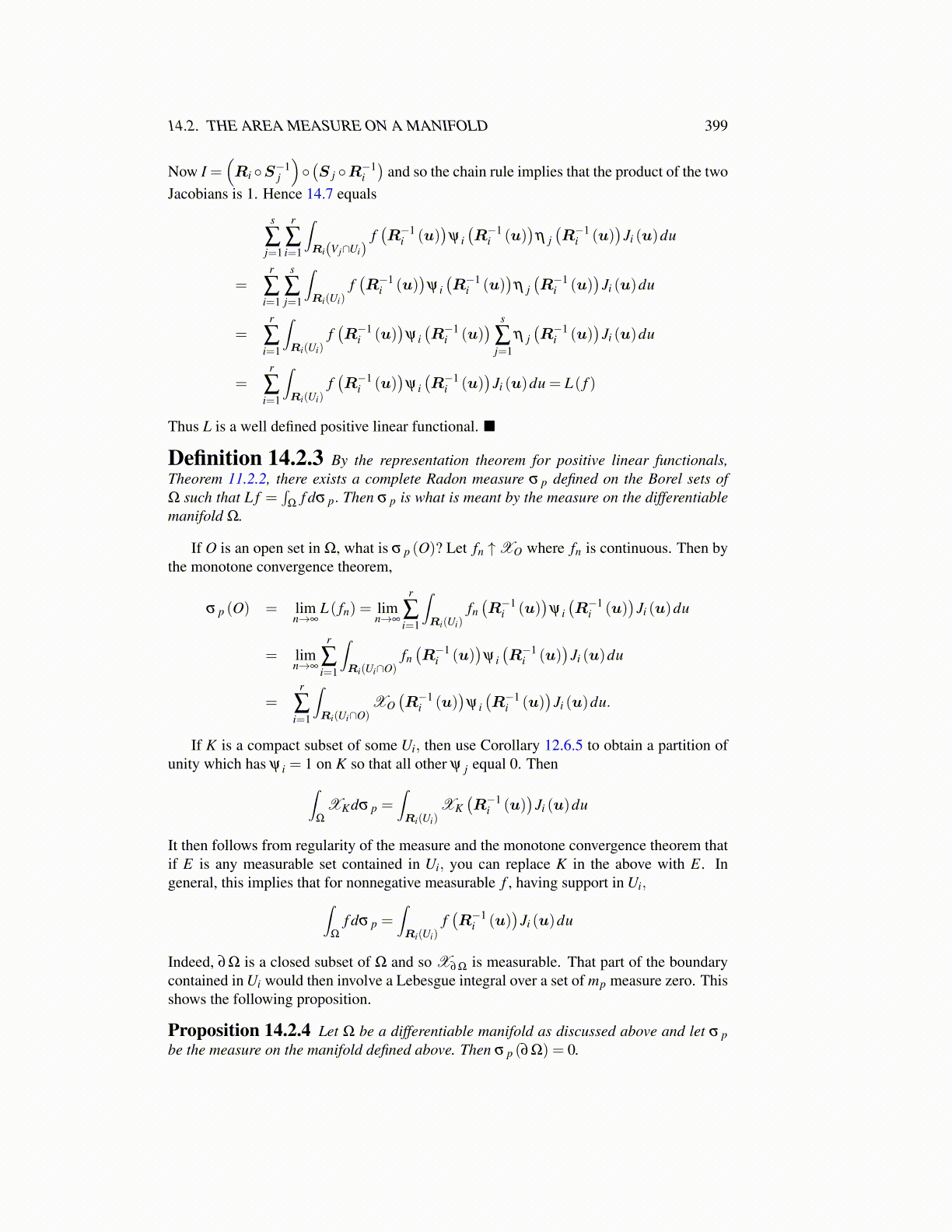
14.2. THE AREA MEASURE ON A MANIFOLD 399
Now I =(Ri ◦S−1
j
)◦(S j ◦R−1
i
)and so the chain rule implies that the product of the two
Jacobians is 1. Hence 14.7 equals
s
∑j=1
r
∑i=1
∫Ri(V j∩Ui)
f(R−1
i (u))
ψ i(R−1
i (u))
η j(R−1
i (u))
Ji (u)du
=r
∑i=1
s
∑j=1
∫Ri(Ui)
f(R−1
i (u))
ψ i(R−1
i (u))
η j(R−1
i (u))
Ji (u)du
=r
∑i=1
∫Ri(Ui)
f(R−1
i (u))
ψ i(R−1
i (u)) s
∑j=1
η j(R−1
i (u))
Ji (u)du
=r
∑i=1
∫Ri(Ui)
f(R−1
i (u))
ψ i(R−1
i (u))
Ji (u)du = L( f )
Thus L is a well defined positive linear functional. ■
Definition 14.2.3 By the representation theorem for positive linear functionals,Theorem 11.2.2, there exists a complete Radon measure σ p defined on the Borel sets ofΩ such that L f =
∫Ω
f dσ p. Then σ p is what is meant by the measure on the differentiablemanifold Ω.
If O is an open set in Ω, what is σ p (O)? Let fn ↑XO where fn is continuous. Then bythe monotone convergence theorem,
σ p (O) = limn→∞
L( fn) = limn→∞
r
∑i=1
∫Ri(Ui)
fn(R−1
i (u))
ψ i(R−1
i (u))
Ji (u)du
= limn→∞
r
∑i=1
∫Ri(Ui∩O)
fn(R−1
i (u))
ψ i(R−1
i (u))
Ji (u)du
=r
∑i=1
∫Ri(Ui∩O)
XO(R−1
i (u))
ψ i(R−1
i (u))
Ji (u)du.
If K is a compact subset of some Ui, then use Corollary 12.6.5 to obtain a partition ofunity which has ψ i = 1 on K so that all other ψ j equal 0. Then∫
Ω
XKdσ p =∫Ri(Ui)
XK(R−1
i (u))
Ji (u)du
It then follows from regularity of the measure and the monotone convergence theorem thatif E is any measurable set contained in Ui, you can replace K in the above with E. Ingeneral, this implies that for nonnegative measurable f , having support in Ui,∫
Ω
f dσ p =∫Ri(Ui)
f(R−1
i (u))
Ji (u)du
Indeed, ∂Ω is a closed subset of Ω and so X∂Ω is measurable. That part of the boundarycontained in Ui would then involve a Lebesgue integral over a set of mp measure zero. Thisshows the following proposition.
Proposition 14.2.4 Let Ω be a differentiable manifold as discussed above and let σ pbe the measure on the manifold defined above. Then σ p (∂Ω) = 0.